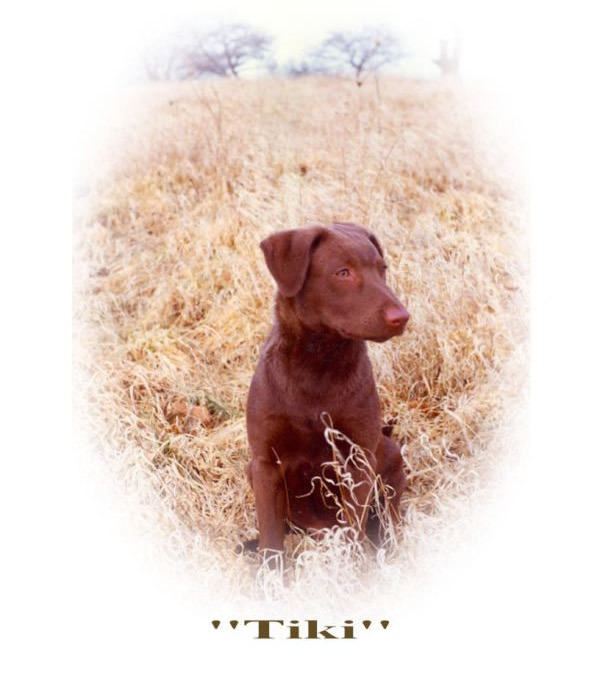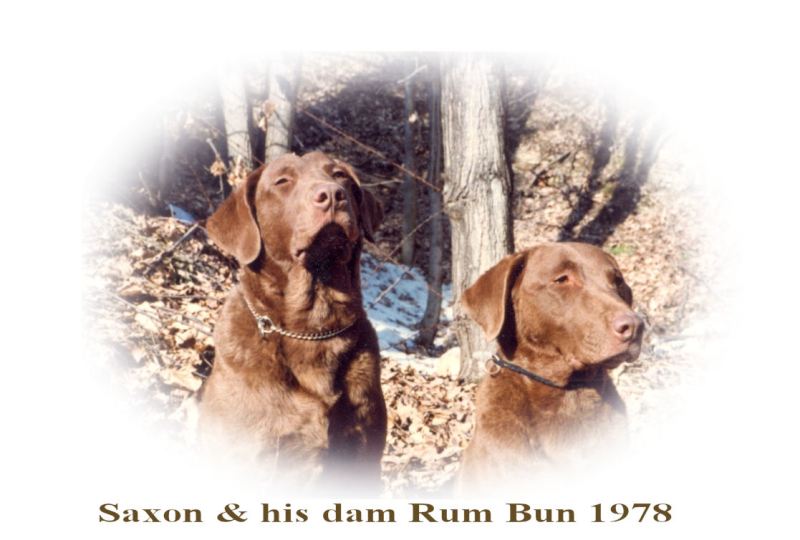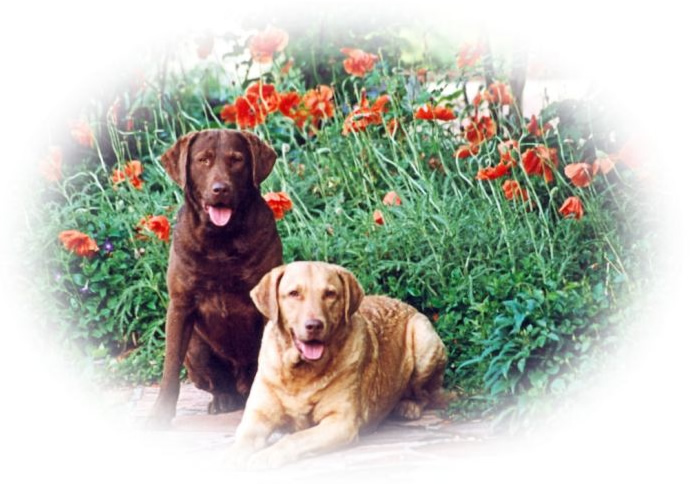How We Started
Reflections
I was always a cat person. I admired their independence and affection that you earned. Bill (my husband) though was a dog man.
One Fall while visiting my favorite aunt & uncle a simple comment set a course that became Pond Hollow Chesapeakes. My aunt & uncle had recently acquired a new puppy and a book on dog breeds. Casually going through the book, Bill came to info on the Chesapeake Bay retriever. The breed's description and photos appealed to him and he said "I like this breed". Had we ever seen one before or heard of one ? No. I was the cat person so who cares about dog breeds.
Christmas that year my aunt kept telling us she had a big surprise for our daughter Jennifer. The surprise-a brown male Chesapeake puppy ! We named him Tamarack "Tiki".

Our first CBR Tamarack "Tiki"
He came from a co-worker of my uncle's who had a litter. No papers and in looks, he did not have much coat but the personality was definitely a Chesapeake. Tiki was a happy dog-loved to retrieve. He was a good guardian that I took to work with me . I often worked alone in a landscaping business and his presence was comforting. He would lay at my feet and when someone came in, he would rise up and just watch them with his yellow eyes. Tiki loved to swim in the pond at our home. We'd say "tiki pond" and this brown streak would race across the yard and leap in with a splash. I grew to love and admire the breed's traits. We live along a road and one day the dreaded thing happened-he was gone.
We had to have another Chesapeake-nothing else would do. This one would be obedience trained too. In 1977, it was not easy to find one. We called around and finally came across Barbara & Sam Mullen "Mitsu Kuma" who had a litter due in April of the year. In June we brought home a brown male that we named Saxon (Ch* Mitsu Kuma's Saxon Pond UD WD-"Bear"). I applied the most scientific method in selecting him-he had a small white chest spot that matched my beloved cat's and he wooed ! His parents though were very well bred-sire an ACC NSS WD & his dam an ACC NSS RWB. Without trying we stumbled into just the type background you would want if you were going to be serious in dogs. We weren't. But we had vowed that this pup would be obedience trained after losing Tiki.

Saxon was a very smart dog. I taught him hand signals by age 9 mos. He was a very easy going puppy-he was like a little adult. I still remember calling Barbara Mullen and asking "when will he act like a puppy". Bill did all his beginning obedience work and put his CD on him. I wanted something to do too so Barbara suggested conformation showing. We'd been to one show (1977 ACC Regional Specialty in Lancaster Pa) and it did not look too hard. I decided to try it.
My best memory from Saxon's show career was his Best in Match with me handling. Match shows were much larger then-this one had nearly 350 dogs. We went to the match for Bill to run him through a Novice routine before his first "real" trial (he was 1st with 198). I took him into conformation and we won Best in Match ! I still remember being asked if I wanted a photo of the win and my answer. "No thanks, I can take of picture of him when I get home". We were hooked. Saxon was a show dog supreme-he loved to show. He easily finished his Ch title handled by Barbara's daughter Sharon.
Later we ended up co-owning his dam with Barbara so I could have an obedience dog to work with along with Bill & Saxon. She became my foundation bitch-Ch Mitsu Kuma's Rum Bun CDX. We bred her once and kept a brother & sister-Ch Mitsu Kuma's Swamp Scout CD WD & Ch Mitsu Kuma's Pond Mist JH CD WD. For our first solely bred litter, we choose the kennel name "Pond Hollow" for the little valley (called hollows locally) that we lived in and the pond that was in it. From here it became a passion for the breed that lasts even today.
A passion that has made many friends and has taken me places I never considered. In 1996 I was invited to judge in Sweden. It was the start of my judging interests. I love to travel and dog shows & judging are good excuses to do it. Judging conformation has taken me to Europe many times and all across the US. I also judged JH level in hunt tests.
At this point, I can't imagine my life without these wonderful dogs !

"BISS" Rocky & his sire "BISS" Bogey Santa Fe, NM 1998
